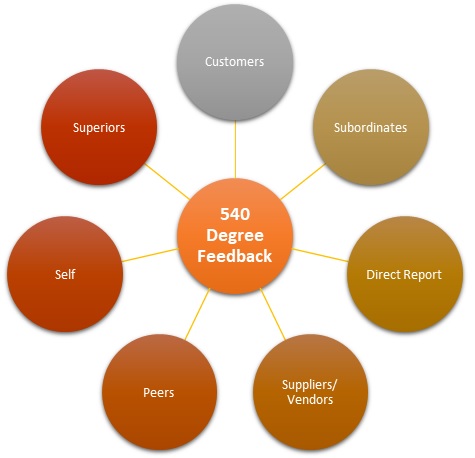- Business Concepts ›
- Human Resources (HR) ›
- 540 Degree Feedback
540 Degree Feedback
Definition, Importance & Example
This article covers meaning & overview of 540 Degree Feedback from HRM perspective.
What is meant by 540 Degree Feedback?
540 degree feedback is an employee performance appraisal method with multiple appraisers. 540 degree feedback includes not only superiors, peers, subordinates, self and even suppliers as well as vendors. The person receives feedback from all the persons he/she has interacted with during the course of fulfilling his/her job responsibilities.
The 540 degree feedback system is used to find shortcoming as well as strengths of the targeted person and can be used as a motivation technique to motivate the targeted person. It involves other relevant stakeholders in the form of customers or clients for the targeted person. These customers and clients are also known as external appraisers. 540 degree feedback is an extension to the 360 degree feedback. Managers should use 540 degree feedback in case of employees who interact with the customers or clients like sales representatives, delivery executives etc. This feedback helps to improve the quality of employees in the workforce.
Importance of 540 Degree Feedback
Any organizational feedback helps an organization to evaluate the performance of its employees. 540 Degree feedback is an addition to the 360 degree feedback model as it helps in surviving the competitive market conditions by getting the customer’s point of view; this can help organizations to orient employees towards achieving high customer satisfaction. Data on Customer perception can help in gaining a competitive advantage or can help an organization to create a Unique Selling Proposition. 540 degree feedback can also help in orienting the content of the training modules and training methods so that the employees can achieve higher customer satisfaction leading to greater revenue and help identifying problems which would not have been possible to identify using traditional feedback systems.

Advantages of 540 Degree Feedback
Some advantages of 540 degree feedback are as follows:
1. Problems which cannot be identified by traditional feedback methods are identified
2. 540 degree feedback gives the customer’s point of view which is necessary in competitive market conditions.
3. Since employees work with suppliers and vendors closely, their feedback helps strengthen business ties.
Difference between 540 Degree Feedback and 360 Degree Feedback
540 degree feedback is an upgrade to 360 degree feedback. It has all the elements of 360 degree feedback system with the addition of external appraisers in the form of stakeholders like customers or clients. It helps in identifying problems which was not possible through 360 degree feedback or any other traditional feedback system.
Example of 540 Degree Feedback
If a salesperson shows differential behavior towards various customers which includes showing preference towards a few customers, showing biases while serving customers, then customer feedback becomes important to identify and rectify such behavior as these types of behaviors can lead to loss of potential customers, organization’s branding and loss in revenue. 540 degree feedback would come to the rescue in such a case and help in identifying such problems so that the organization can correct the behaviors or weed out the employees. Employees that are doing well should be rewarded, feedback can be taken from the customer in the form of a questionnaire or a simple rating system. In case of delivery executives, customers can additionally point out through a feedback form or questionnaire that the executive was not well groomed or was not courteous while delivering the product.
Hence, this concludes the definition of 540 Degree Feedback along with its overview.
This article has been researched & authored by the Business Concepts Team which comprises of MBA students, management professionals, and industry experts. It has been reviewed & published by the MBA Skool Team. The content on MBA Skool has been created for educational & academic purpose only.
Browse the definition and meaning of more similar terms. The Management Dictionary covers over 1800 business concepts from 5 categories.
Continue Reading:
What is MBA Skool?About Us
MBA Skool is a Knowledge Resource for Management Students, Aspirants & Professionals.
Business Courses
Quizzes & Skills
Quizzes test your expertise in business and Skill tests evaluate your management traits
Related Content
All Business Sections
Write for Us